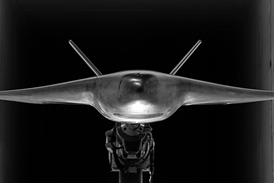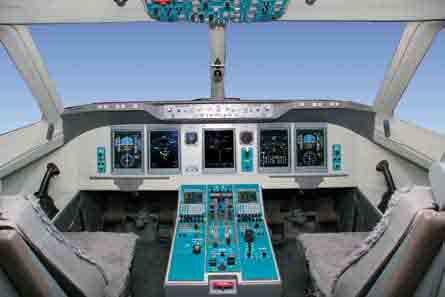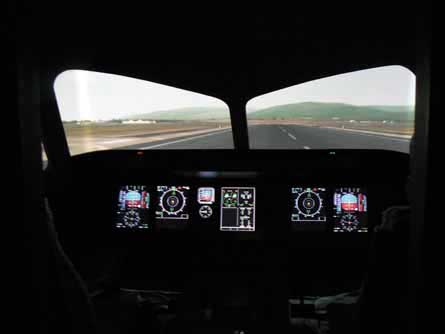Two decades after Airbus produced the first sidestick-equipped fly-by-wire airliner, Sukhoi has tried to improve the concept for its Superjet 100
It is remarkable that almost 20 years have passed since the first fly-by-wire commercial aircraft with sidestick controllers, the A320, took to the air, yet Airbus remains the only manufacturer to produce airliners configured in such away.
|
|---|
The SSJ is being developed by Sukhoi and a team of international suppliers |
Until now, that is. When the Sukhoi Superjet 100 (SSJ) flies in a little under a year from now, the flightdeck layout will be familiar to any Airbus fly-by-wire (FBW) pilot. But Sukhoi Civil Aircraft (SCAC), which is responsible for the design of the new 75- to 100-seat regional jet family, has endeavoured to improve upon the benchmark set by Airbus for a sidestick-equipped airliner in both the design and feel of the controller, and the flight control laws and envelope protection. And after flying the engineering simulator at Russian aerospace institute TsAGI in Zuhkovsky near Moscow, Flight International can confirm that the SSJ designers have developed some interesting variations on the theme introduced by Airbus 20 years ago.
The control station is adjacent to the development simulator in a building at the Zuhkovsky research centre |
Although it has a full visual system, the fixed-base simulator built for SCAC by Russian training specialist CSTS Dinamika is basic, with only the primary instruments and controls provided. This includes the Thales-developed five-screen electronic flight instrument system, a sidestick controller for each pilot, rudder pedals/footbrakes, basic power levers, and controls for flaps, spoilers, trim and landing gear. "We will incorporate production-standard controls in the first quarter of next year," says the head of SCAC's performance team, Alex Dolotovsky.
A basic control station is located outside the simulator with a keyboard and joystick interface and large flat-panel screens to display the instruments, visual system, map and control law algorithms. This enables the SSJ to be "flown" from outside the actual simulator.
The decision by SCAC to adopt the sidestick in place of a conventional control yoke was remarkable in the first place, given that Boeing has been on board the Russian airliner programme since the beginning, providing consultancy services. Although the US manufacturer introduced digital flight controls with the 777 in 1995, almost a decade after its rival, it is famously and philosophically opposed to the idea of a sidestick - despite the fact that the mechanical leverage provided by a control yoke is effectively made redundant by electrically signalled FBW.
"Boeing was opposed to us adopting the sidestick controller," says SCAC president Victor Subbotin. "We had some long teleconferences with Boeing's flight safety people about the advantages of a control yoke. But we did another thing that Boeing had advised us to do - listen to our customers - who were unanimously in favour of the stick."
Flightdeck configuration
|
|---|
The SSJ cockpit (shown here in mock-up form) is equipped with sidesticks and bears striking similarity to the A380, for which Thales also supplies the avionics |
Stepping into the SSJ development simulator presents a familiar scene for someone used to Airbus FBW cockpits. The arrangement is similar to that in the latest Airbus, the A380. At first glance, the sidesticks look familiar - they are produced by the same supplier Airbus uses - but on closer examination, the differences start to appear.
"We have worked to improve the ergonomics and feel of the sidestick. It is longer than the Airbus one and we've changed the kinematics," says Dolotovsky, adding: "This is the pre-production prototype and we're still working on the grip shape and button location." Dolotovsky says that SCAC spent much effort improving the feel and response of the controller. "We've tried to make it feel like a mix of a sidestick and a centre stick."
One area where SCAC has adopted a more Boeing-orientated philosophy is the throttle levers. As in all airliners except Airbus FBW models, the SSJ's power levers will be servo-driven to move in response to thrust changes when the autothrottle (AT) is engaged - and there are none of the "TOGA, FLEX and CLB" detents found on an Airbus throttle quadrant. On the SSJ development simulator, however, the production standard is not represented.
Another area of the cockpit where SCAC has taken a different route to Airbus is in design of the multipurpose control and display unit (MCDU). Again this is not reproduced on the simulator, but a mock-up of the design follows the traditional "ABCD" keypad layout that Boeing has adhered to for 787, rather than the "QWERTY" keyboard configuration Airbus has adopted for the A380.
Like Airbus, the envelope protection provided by the digital flight control system ensures that in a low-speed/high-angle-of-attack "Alpha-floor" scenario, maximum power is automatically selected even if the autothrottle is disengaged - in which event the power levers will be motored to the "firewall" position.
Realistic simulation
The control-law logic is being developed by an SCAC team in Moscow, in liaison with flight control system supplier Liebherr-Aerospace Lindenberg in Germany, using windtunnel test data from Russian research centres in Moscow and Siberia. The simulator at Zuhkovsky enables Sukhoi test pilots to "flight test" the SSJ control laws in a realistic environment. Dolotovsky says the SCAC-developed control laws will be transferred to Liebherr, who will write the software for the control system.
Tests of the flight controls are under way on rigs at Liebherr's facilities, and SCAC has developed an "electronic bird" and an "all-aircraft equipment integration rig", which contains all the avionics and systems to enable the control laws to be tested and debugged. Dolotovsky says the well-regarded control laws of the A320 and its siblings have been mirrored or improved upon for the SSJ. The roll/bank, pitch and speed protection is "close to the Airbus ideology", he says, although SCAC has introduced some interesting auto-deployment/retraction functions for high-lift devices and spoilers to further improve safety.
To demonstrate this, we "flew" the SSJ at 180kt (333km/h) with high-lift devices at "Flap 2" and then accelerated the aircraft through the maximum speed for that configuration. There is initially an automatic pitch-up and spoiler deployment (along with master caution and EICAS warnings), but continuing to accelerate results in the automatic retraction of flaps and slats to zero. The EICAS continues to show that the flap lever is positioned at "Flap 2", but the hollow rectangles denoting the position of the flaps and slats indicate that actual devices are retracted. We then slow to 180kt and the flaps and slats redeploy. "The high-lift devices' positions will always match the lever setting when they can," says Dolotovsky.
An extension of the auto-deployment feature is offered in the clean configuration with the flap lever at zero. We fly the aircraft clean and allow the speed to decay to less than 200kt. Rather than preventing us from flying below minimum clean speed, the software triggers auto-deployment of the slats (accompanied by a master caution) as the lever is still at the zero position. If flap retraction is commanded at too low a speed, the devices remain deployed until a safe speed is achieved.
Angle-of-attack protection follows the Airbus philosophy, with a full aft stick deflection at low speed achieving a maximum angle-of-attack at a speed close to CLMAX, but just below the stall speed. "There will be no stall warning in clear air conditions," says Dolotovsky.
The flight control system has three modes - normal, degraded and minimum. Normal is where all primary flight control units (PFCU) and fight controls are functioning. Degraded is where some input signals are lost - for example, if data is missing from the air data or inertial reference system. "Autopilot is not available in this mode, but manual handling is close to optimum, although envelope protection algorithms are degraded," says Dolotovsky.
Control laws
Minimum mode, when all PFCU, air-data or inertial-reference input is lost, is close to Airbus's "direct law", but with improved manual handling qualities as the damping is still available in roll, yaw and pitch channels. "There is no envelope protection, but handling qualities are close to normal," says Dolotovsky. He adds that the improved handling in minimum mode was well received by SSJ launch customer Aeroflot, which says that the aircraft's control laws are more acceptable compared with Airbus FBW, which lacks Dutch roll damping in direct law.
|
|---|
The SSJ fixed-base development simulator has a full visual system and basic controls and instrumentation |
One area of Airbus FBW control that comes in for criticism is the behaviour in crosswinds, where pilots can sometimes find that full-stick roll input cannot counter a rising wing. "We have worked hard on the crosswind performance, and our control laws are different to Airbus and closer in behaviour to a conventional aircraft," says Dolotovsky. SCAC also aims to improve the feel of the SSJ in the landing flare over today's FBW airliners. Dolotovsky says that whereas the Airbus system transitions to direct law in the final moments of an approach, the SSJ's will not. After an ILS-assisted approach to land, I took off again and flew the SSJ on a tight visual circuit. Handling in the low-speed configuration close to the ground was good, with the aircraft proving manoeuvrable.
The prototype SSJ is coming together at the final assembly plant in Komsomolsk-on-Amur in Siberia, and the first SaM146 engine produced by Snecma and NPO Saturn will to begin flight trials on an Ilyushin Il-76 testbed in February. A year from now, the SSJ should be into its flight-test programme and showing how well the FBW theory translates into practice.
Source: Flight International



























